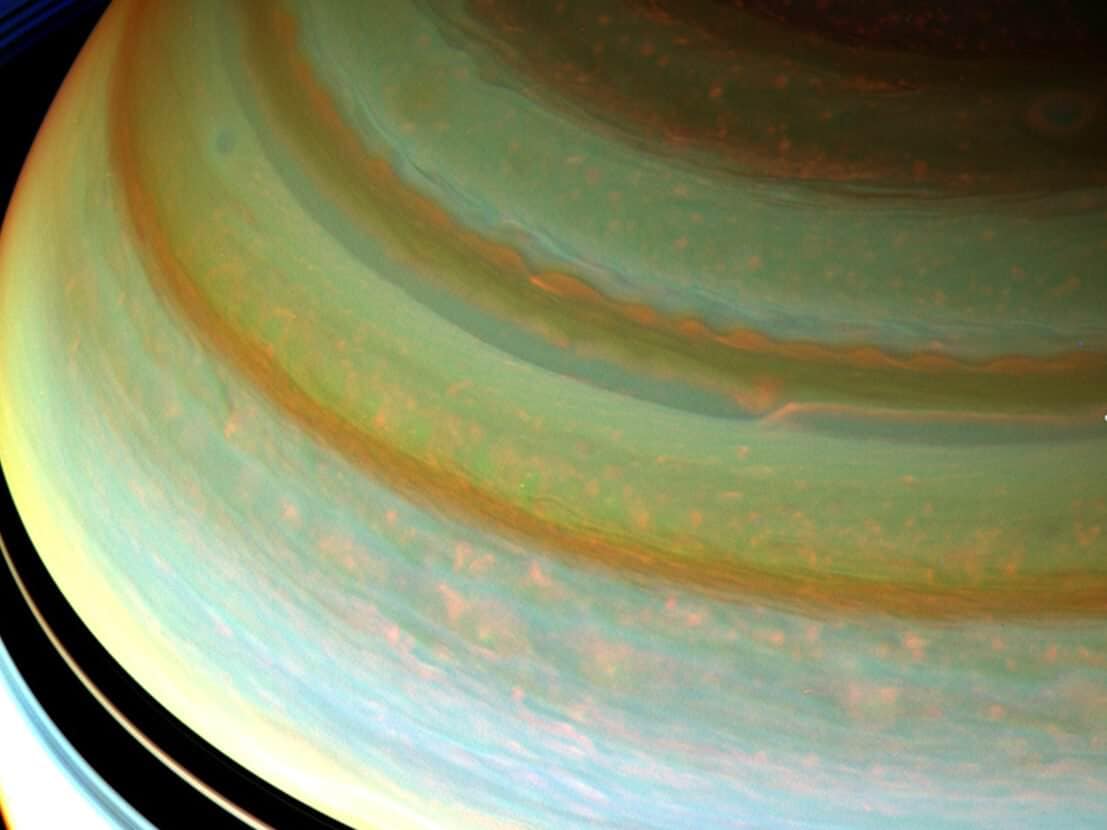Saturn, the sixth planet from the Sun, is known for its impressive atmosphere. With its similar composition and rotational features to Jupiter, it is often referred to as a sister planet.
Among all the planets in our solar system, Saturn stands out as the most recognizable. Its most notable feature is its expansive and stunning ring system, which surpasses any other planet’s ring belt in terms of grandeur.
Unlike other planets, Saturn’s exploration has been limited due to its late discovery by ancient civilizations and the challenges faced by modern scientists. However, thanks to the Cassini spacecraft, we are continuously gathering new information about the planet, its satellites, and its magnificent rings.
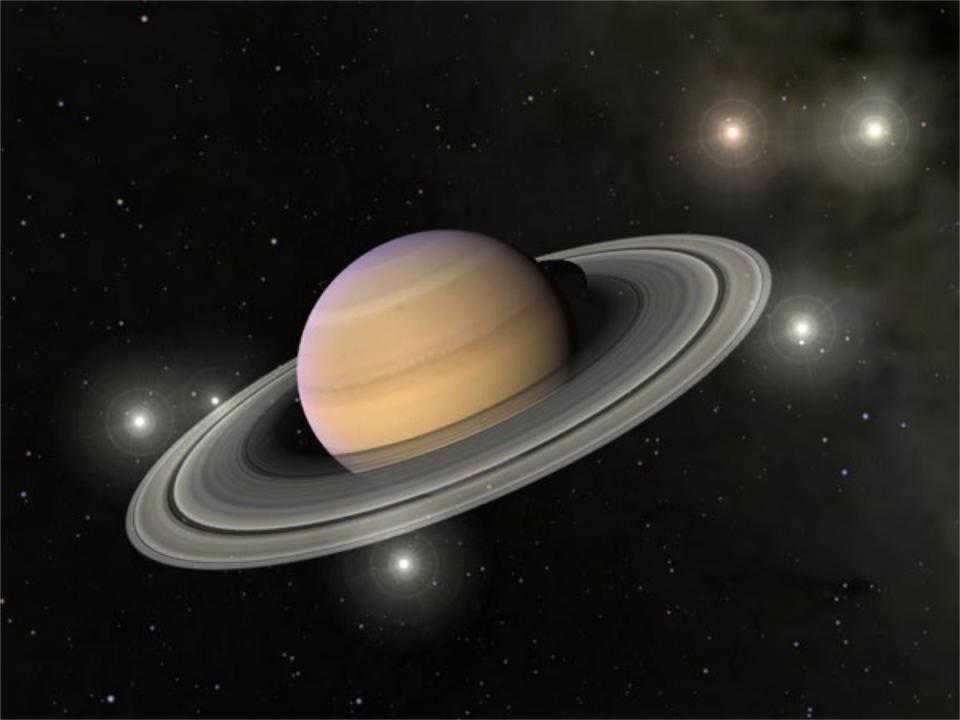
Atmosphere
Saturn’s atmosphere is composed of hydrogen (96.3%) and helium (3.25%). Additionally, it contains methane, ammonia, phosphine, and ethane.
In the visible light spectrum, Saturn’s atmosphere appears calmer compared to its sibling planet, Jupiter. Scientists have observed clusters of faintly visible cloud bands with a pale orange color. This hue is a result of the atmosphere’s high concentration of sulfur compounds.
The upper layers of Saturn’s atmosphere also contain nitrogen and oxygen, which, when exposed to sunlight, combine to form molecules resembling “smog”. Recent data from research vehicles suggest that the planet’s atmosphere is turbulent and awe-inspiring.
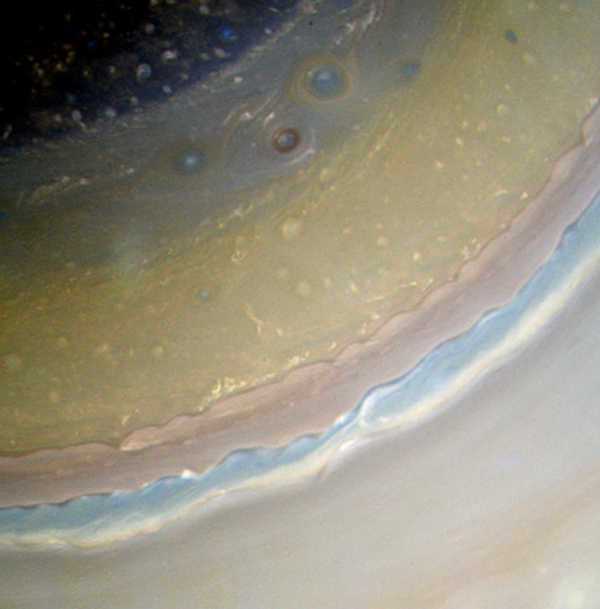
Saturn stands out from other planets due to its unique feature of experiencing extremely fast winds. Measured by the Voyager spacecraft, these winds have been recorded to reach speeds exceeding 1800 km/h, a phenomenon unmatched by the wind patterns observed on Earth or any other celestial bodies within our solar system. These high-speed winds give rise to the formation of distinctive white storms that encircle Saturn in bands.
Fascinatingly, these bands of storms have a relatively short lifespan, typically lasting only a few months before being absorbed back into the planet’s atmosphere.
Temperature
Ammonia is the main component of atmospheric clouds. These clouds are found in the region that is 100 kilometers below the upper part of the troposphere, and the temperature in this area can drop as low as -250 degrees. If you descend further, the clouds are made up of ammonium hydrosulfide, and the temperature in this region often fluctuates and can reach -70 degrees.
Deeper clouds, located 130 kilometers below the tropopause, are composed of water. The temperature in this part is always above 0 degrees.
The pattern of cloud formation is as follows: the closer to the tropopause, the higher the temperature, and the greater the proportion of liquid compared to hydrogen gas.
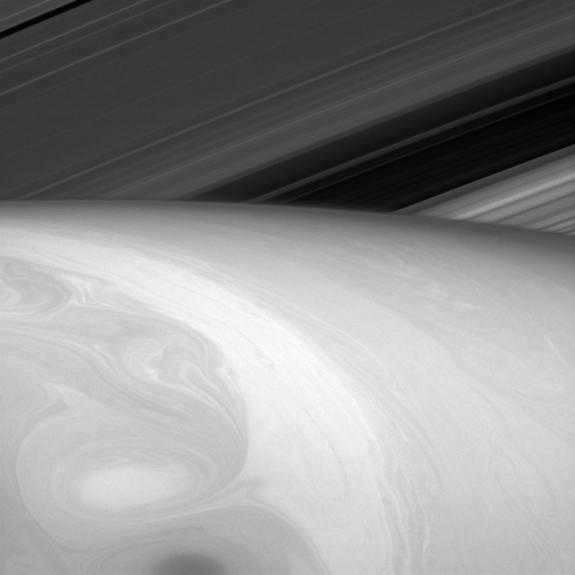
Hexagon
An extraordinary occurrence witnessed by scientists in the atmosphere of Saturn is known as the hexagon. This peculiar phenomenon involves the presence of hexagonal clouds encasing a swirling hurricane. The hexagon spans a colossal diameter of 25,000 km, which is four times greater than the Earth’s diameter.
The rotational velocity of the hexagon matches that of the planet itself. Within this extraordinary structure lies a massive vortex in the form of a hurricane. A single revolution around its axis takes approximately 639 minutes.
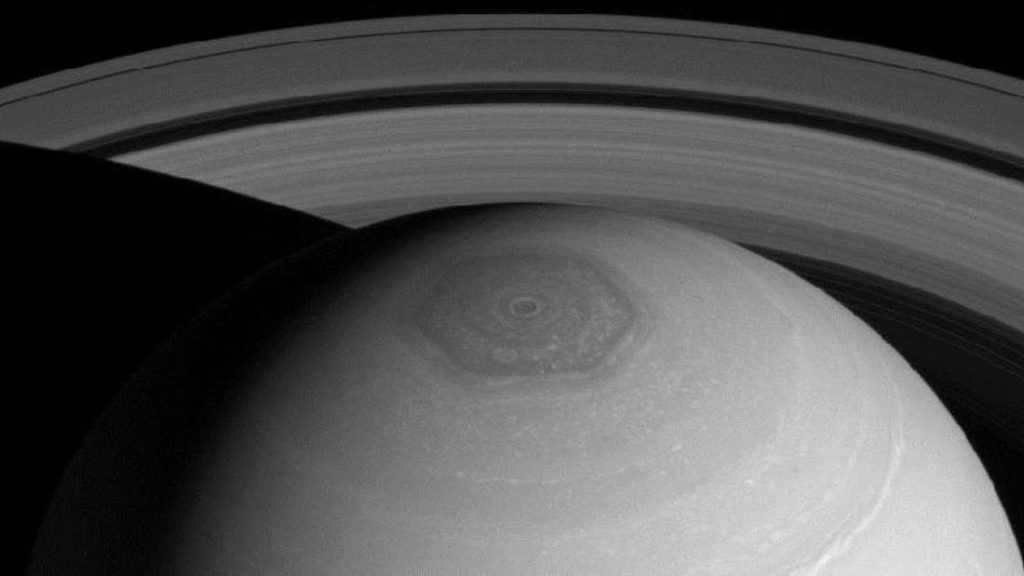
Composition
Similar to the rest of the gas giants in our solar system, Saturn is composed mainly of hydrogen and helium. It is important to note that Saturn does not possess a traditional solid surface.
When one imagines landing on Saturn, they may envision a solid ground. However, this is far from the reality. Instead, the planet’s atmosphere consists of ever-changing gases with varying pressures and temperatures. Any object that attempts to descend onto Saturn would be crushed and absorbed into the vast depths of its gaseous composition.
From a distance, other planets may appear to have solid surfaces akin to our own Earth. However, this is merely an illusion. In truth, these planets are nothing more than gas-filled spheres, with temperature and pressure levels in constant flux.
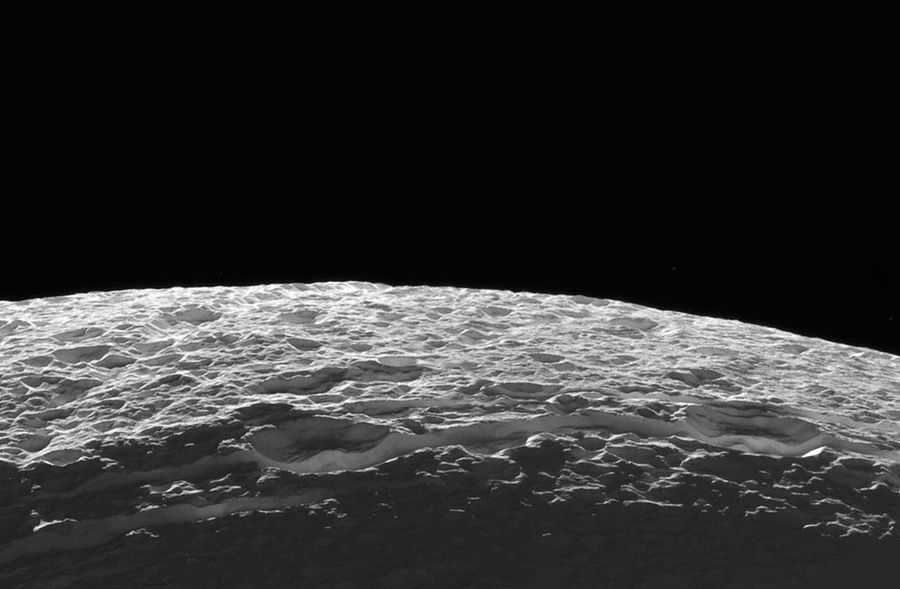
Composition and structure
Saturn’s composition and structure closely resemble those of its sibling planet, Jupiter. The planet can be divided into three distinct parts.
Firstly, there is an inner layer consisting of a silicate core, which is approximately 20 times more massive than the Earth. This core is believed to be surrounded by a layer of liquid metallic hydrogen (the second part).
The third part is the outer layer, composed of molecular hydrogen. The main difference between Saturn and Jupiter lies in the thickness of their outer layers. Saturn’s hydrogen layer measures 14,500 km in thickness, whereas Jupiter’s hydrogen layer is 18,500 km thick. In contrast, Jupiter’s outer layer is 46,000 km thick, while Saturn’s outer layer is 122,000 km thick.
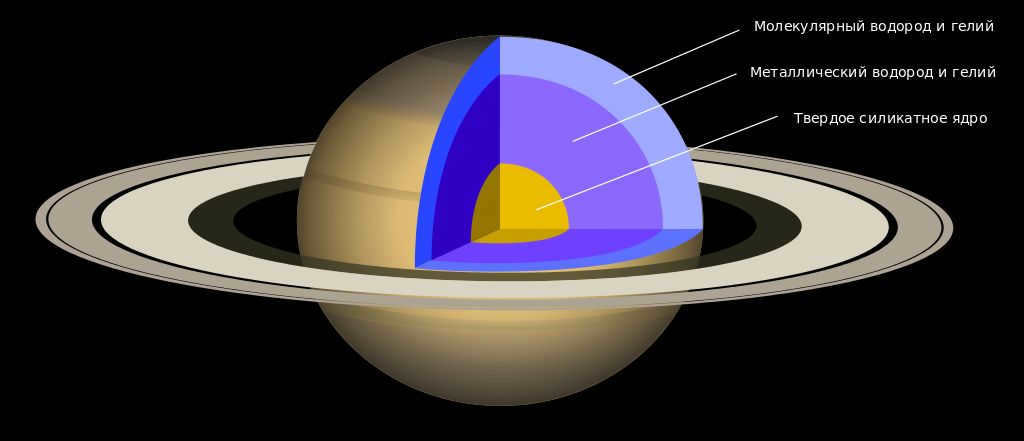
The emission of radiation from Saturn exceeds the amount it receives from the Sun by a factor of 2.5. This phenomenon is linked to the Helmholtz mechanism, which suggests that the planet’s energy is generated through gravitational compression and the influence of its massive size.
Therefore, it can be deduced that Saturn has a lower density compared to water, which implies that if the planet were placed in a vast ocean, it would be able to float.
What is Saturn’s atmosphere like? This description is aimed at children and covers various aspects such as the presence and composition of the atmosphere, the chemical elements found in different layers, the temperature, climate, weather, and even the famous hexagon shape.
For younger audiences, it’s important to explain why Saturn is referred to as a gas giant. While its massive size is a major factor, another key reason is that it lacks a solid surface. The dark atmosphere and interior of Saturn seem to seamlessly blend together without a clear transition line. We’ve established that Saturn does indeed have an atmosphere, so now let’s delve into its chemical makeup.
An introduction to explaining the concept of planets to children by their parents or educators in school could involve highlighting the fact that the planet is primarily composed of hydrogen, which it managed to capture during its initial formation. In addition to hydrogen, other elements such as ammonia, methane, nitrogen, and oxygen are also present.
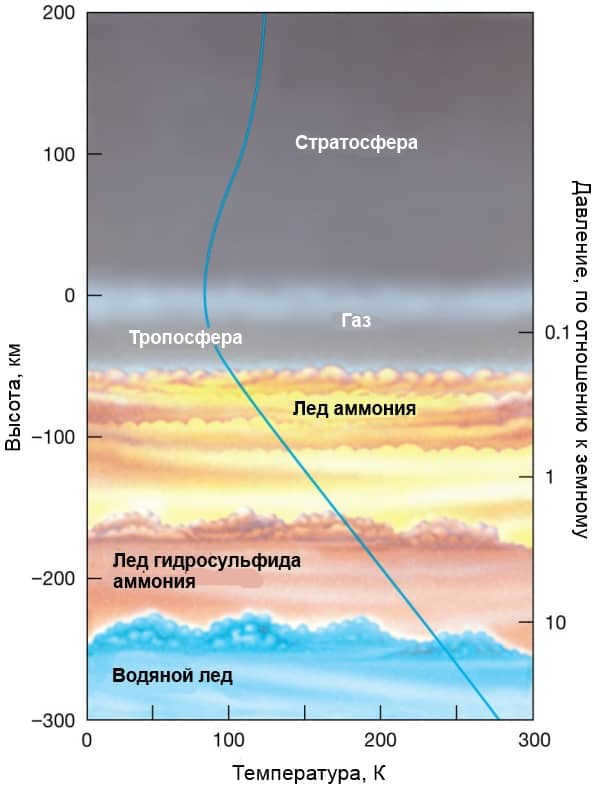

Variation of atmospheric pressure and temperature with altitude

Despite the fact that helium makes up nearly a quarter of Saturn’s total mass, it only accounts for 7% of the atmosphere. This means that the majority of the helium is actually submerged in hydrogen. The distance from the star plays a role in maintaining cold temperatures for these gases. It is important for children to understand that there are traces of water on the planet, but they exist in the form of atmospheric ice. The point at which the pressure reaches one bar (equivalent to sea level on Earth) is considered the surface of Saturn.
Just like on Jupiter, Saturn also possesses layers of clouds, albeit less bright. The width of the bands increases as they approach the equatorial region. The zones, which consist of colder gases rising, are wider in comparison to the belts, which comprise of warmer gases falling. Furthermore, Saturn contains a higher concentration of sulfur, resulting in the zones and belts being adorned with shades of orange and smog-like hues.
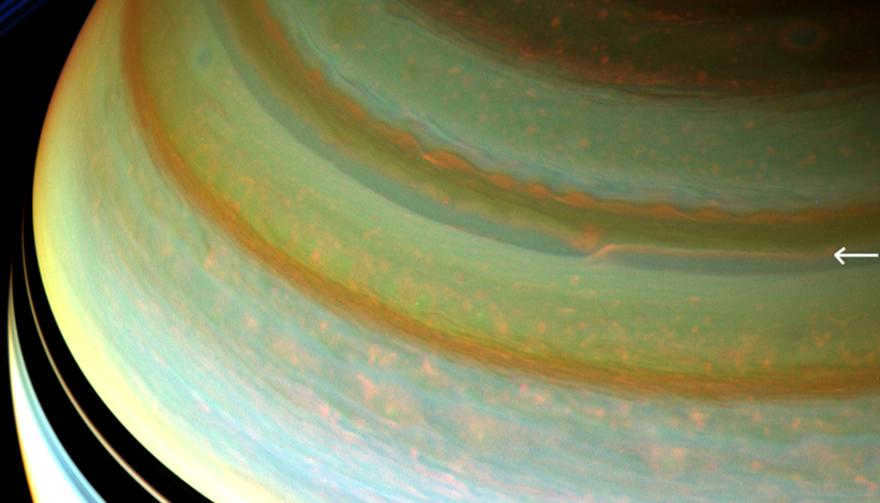
On January 13, 2008, the Cassini spacecraft captured an image of a powerful jet stream in the northern hemisphere of the planet, from a distance of 1.3 million km.

The temperature and pressure of Saturn increase as you move from the outer layers towards the core. It is interesting to note that the composition of the clouds also changes accordingly. The upper clouds consist of ammonia ice, while closer to the core, there are clouds of water ice mixed with streaks of ammonium hydrosulfide. The lower layers of Saturn’s atmosphere have higher temperatures and pressures, and this is where droplets mixed with ammonia can be seen.
It is important to explain to children that Saturn has the fastest winds in the entire solar system. These measurements were taken by NASA’s Voyager mission, and the winds were found to exceed 1800 km/h at the equator, mostly blowing in an easterly direction. The wind speed decreases as you move higher up in the atmosphere.
Explaining Saturn’s Cloud Patterns to Kids
Saturn has some really cool cloud patterns in its atmosphere. When the Voyager spacecraft flew past the planet in the 1980s, it saw some clouds that were shaped like hexagons near the north pole. These clouds were pretty unique and interesting. Then, when the Cassini spacecraft arrived 25 years later, it took pictures with a special camera that can see infrared light. These pictures showed that the hexagon-shaped storm was still moving really fast, at a speed of 100 meters per second! That’s super speedy! And guess what? This storm is huge! It’s about 25,000 kilometers wide, which is big enough to fit two whole Earths inside!
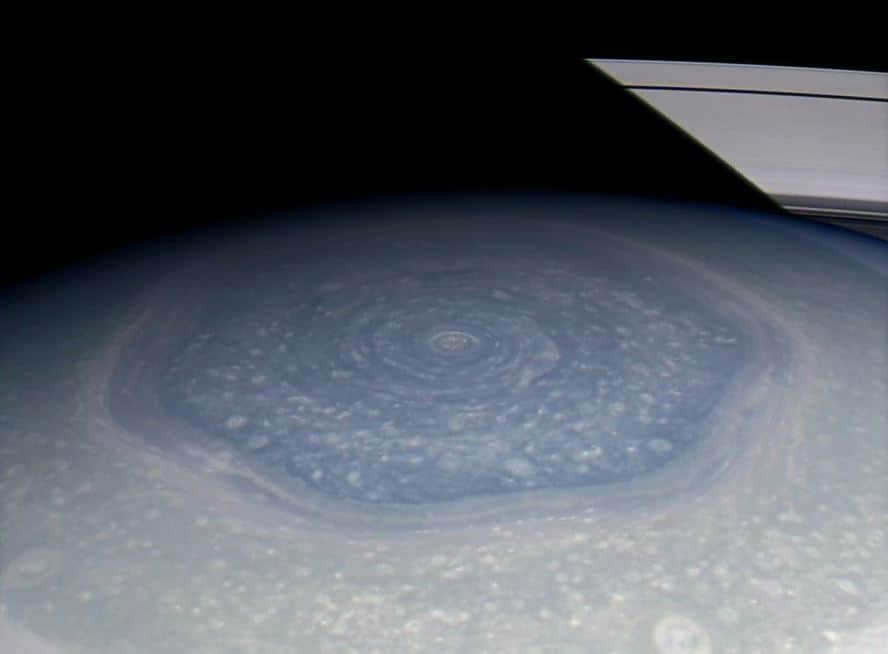

The origin of the unusual hexagon at Saturn’s north pole remains a mystery to scientists.
While there are other distinctive features, none of them are as enigmatic as this hexagon. Despite extensive research, scientists have been unable to provide a conclusive explanation for its existence.
Another fascinating aspect of Saturn’s atmosphere is the occurrence of giant thunderstorms known as the Great White Spots. These powerful storms only happen once a year, specifically during the summer solstice in the northern hemisphere. This phenomenon, which is equivalent to once every 30 years on Earth’s time frame, is something that children should learn about to gain a better understanding of Saturn’s atmospheric dynamics.
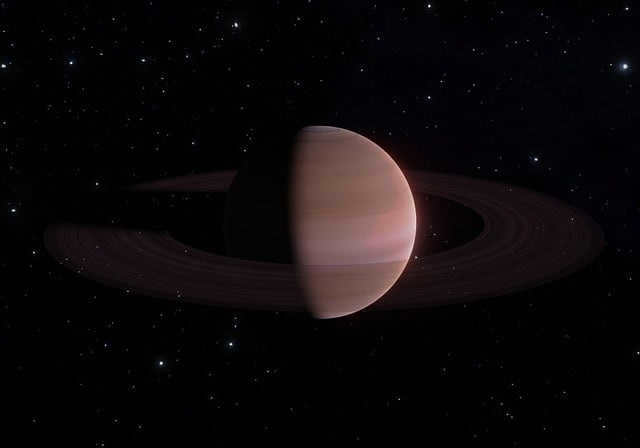
Saturn is the sixth planet from the Sun in the Solar System. What sets this celestial body apart is its iconic rings. However, Saturn also possesses numerous other fascinating characteristics.
Exploration History
Observing the night sky allows for the naked-eye view of this planet, eliminating the need for any technical devices. Consequently, it is impossible to definitively attribute the discovery of Saturn to a single individual. The study of this planet has been ongoing since ancient times and continues to this very day.
Discovery of Saturn
Pinpointing the exact date or even century of Saturn’s discovery is impossible since it can be seen with the naked eye when looking at the sky.
In-depth scientific studies of Saturn began in ancient times. The ancient Greeks referred to this celestial body as “Kronos,” after their god of fertility. The Romans later renamed it after their own deity, Saturn, who held similar attributes to Kronos. However, the knowledge of its existence was common to both civilizations.
The ancient scientist and philosopher Ptolemy used the astronomical knowledge available in his era to calculate the planet’s trajectory.
In the Modern Age, the exploration of Saturn was reignited with the renewed fascination for science. The study of this celestial body is closely intertwined with the renowned intellectuals of the Enlightenment era.
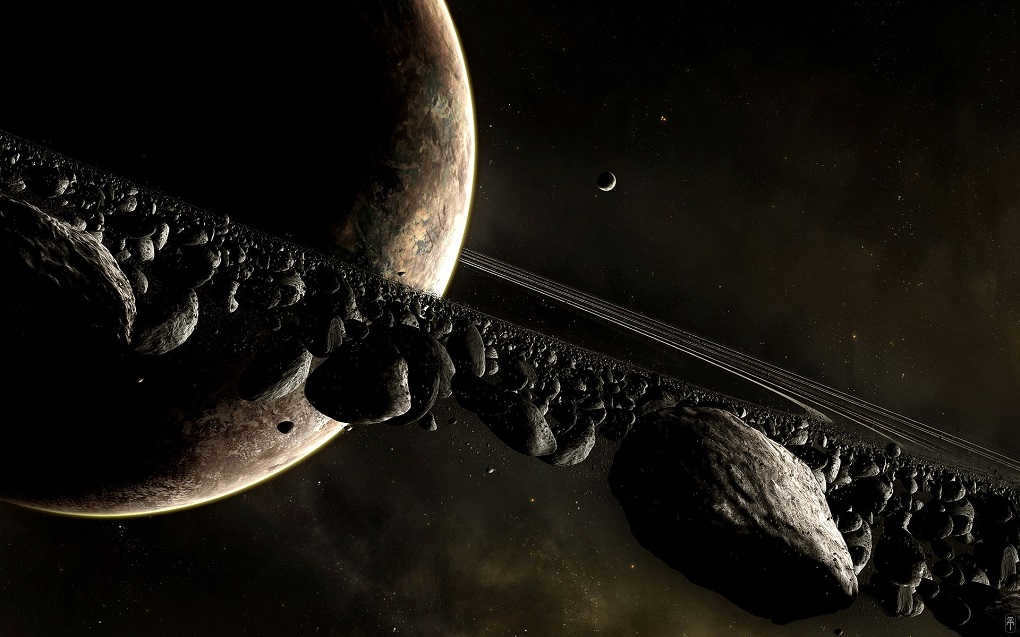
Who made the discovery
The identity of the ancient person who first laid eyes on Saturn remains a mystery. This celestial object could be observed without the aid of later technological advancements. The Romans, however, were the first known civilization to have knowledge of Saturn, and they bestowed upon it the name that is still used today.
Ptolemy, an esteemed scientist of antiquity, calculated the orbit along which Saturn travels. Galileo Galilei, another renowned explorer, subsequently made significant observations about Saturn. In the early 17th century, while gazing at the sky through a telescope, Galileo noticed the presence of rings around the planet. However, he initially mistook them for satellites of the planet and did not comprehend their true nature.
Currently, teams of scientists and space exploration specialists are actively involved in studying Saturn. Back in the 70s and 80s, spacecraft were sent to this fascinating planet.
The Origin of Saturn’s Name
In ancient times, the planet we now know as Saturn was referred to as “Kronos”. The ancient Greeks named it after one of their revered and powerful gods, who they believed bestowed upon them bountiful harvests.
With the Roman Empire’s dominance over Greece, many celestial objects were bestowed with new names. Kronos was not exempt from this renaming tradition. Ever since the Roman Empire’s grandeur and up until today, the planet is referred to as Saturn.
Essential details about Saturn
Saturn, situated as the sixth celestial body from the Sun, spans a distance of 1.43 billion kilometers. As a result, it holds the distinction of being the farthest visible planet in our solar system without the need for specialized equipment.
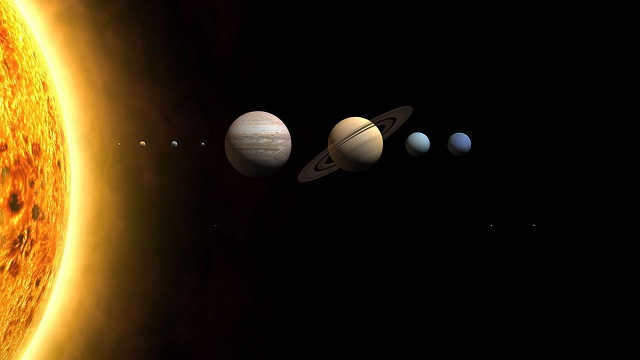
Saturn’s Age
The age of Saturn has been determined by scientists to be 4.6 billion years – just like all other major objects in the solar system. It is believed that this gas giant originated from a nebula that gradually increased in density over time and eventually formed into a planet.
During its initial formation and for the first 600 million years, Saturn did not possess any rings. These rings only developed later on. In fact, the rings surrounding Saturn are estimated to be no older than 4 billion years. This conclusion was reached by scientists during their extensive research.
Size, mass and orbit
What are the dimensions and characteristics of Saturn? The immense gas planet has a volume of 82,713 x 10*10 km3. Scientists have determined that the average radius of Saturn is 58232 km, while the average diameter is 116,464 km. In terms of mass, Saturn weighs in at 568.46 x 10*24 kg. Furthermore, the gas giant follows an orbit with an eccentricity of 0.0565.
Composition and Structure
Saturn’s surface is characterized by an incredibly low density, as it is primarily composed of gaseous elements. Its composition primarily consists of molecular hydrogen gas, which is mixed with helium.
The atmosphere of Saturn is composed of various elements. Beneath the outer layer, there exists a layer of liquid helium and metallic hydrogen. Additionally, there are some volatile substances present, although scientists have not yet determined their exact composition.
At the center of the planet lies a solid core. This core has a radius of 12,500 kilometers and is incredibly hot, with temperatures reaching almost 12,000 degrees Celsius. Researchers who study Saturn’s composition speculate that the chemical makeup of this core may be similar to that of Earth’s core.
Saturn is a gas giant with a typical structure. Its atmosphere consists of various layers of gases in the upper regions, with liquid layers beneath. At the core of this celestial body lies a metallic core.
Scientists have extensively studied the composition of Saturn’s atmosphere. It is primarily composed of hydrogen and helium, along with traces of methane and ammonia. Additionally, there are other elements present in smaller amounts.
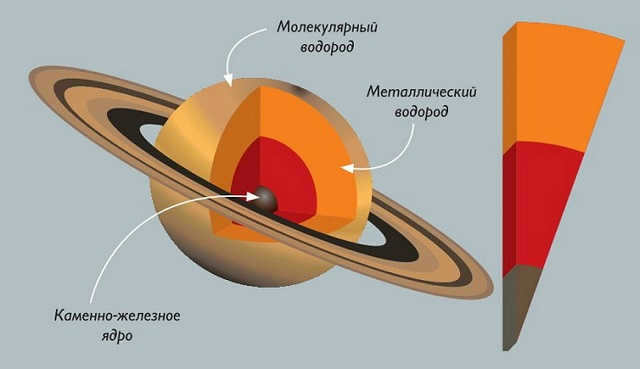
Orbit and rotation
Ptolemy, an ancient thinker, was the first researcher to estimate the approximate size of Saturn’s orbit. Subsequent scientists have refined this information. Saturn’s orbit is closest to the Sun at a distance of 9 astronomical units (a.u.) from the center of the solar system, and the farthest point is 10.1 a.u.
Composition of Saturn’s Atmosphere
The atmosphere of Saturn consists of a unique blend of gases. It is primarily composed of approximately 75% hydrogen, which is a commonly known substance, and around 25% helium gas.
Distinctive Characteristics of Saturn’s Atmosphere
In comparison to its neighboring planet Jupiter, Saturn’s atmosphere appears to be less turbulent. It showcases clusters of expansive clouds and bands with varying colors, although they are relatively mild. The upper layer of Saturn’s atmosphere contains traces of sulfur, which imparts a reddish hue to the clouds. Additionally, small amounts of nitrogen and oxygen can be found.
The surface temperature of Saturn is approximately -150 degrees Celsius, and it experiences different seasons, similar to Earth.
Atmospheric Winds on Saturn
Saturn is renowned for its atmospheric winds, which give rise to incredibly powerful storms. When a satellite was sent by NASA to measure wind speeds on this extraordinary planet, the results were mind-boggling: the winds were blowing at speeds of approximately 1800 km/hr. These intense storms form in specific regions around the planet and can persist for several months before dissipating into the atmosphere.
Within Saturn’s atmosphere, there are clouds that contain ammonia and are situated beneath the uppermost layer. These clouds have a frigid temperature of around -250 degrees Celsius. As we descend deeper into the atmosphere, the temperature of the clouds increases to about -70 degrees Celsius. The lowest clouds, akin to the water we are familiar with, have a temperature of 0 degrees Celsius.
This planet is home to one of the most remarkable weather phenomena observed in our solar system. It is known as the “hexagonal storm,” a name that may intrigue those unfamiliar with it.
The discovery of clouds with six angles was made by the Voyager spacecraft during data collection in the 1980s. However, it was only recently that a high-quality image of the hexagon became available. This unique feature has a diameter exceeding 25,000 kilometers and takes the form of a perfect hexagon. Remarkably, it rotates at the same rate as the planet Saturn itself.
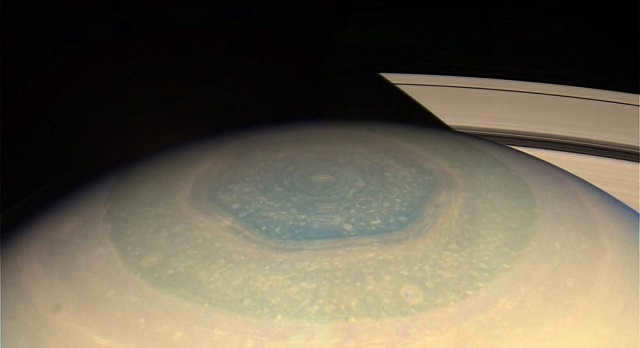
Understanding the Origin of the Hexagonal Formation
The formation of the hexagon on Saturn remains an enigma that perplexes scientists. This peculiar storm possesses a distinct and well-defined shape, unparalleled in any other planet within our solar system.
Rings
One of the most well-known features of Saturn is its distinctive rings. These rings are composed of ice particles with traces of darker impurities.
The ice particles farthest from the planet are the purest, giving the rings their blue and blue color. They follow a specific path as they orbit around Saturn. Some of the largest rings can be easily seen from Earth through a telescope.
How many rings does Saturn have? There are a total of eight main rings, designated by the letters A to F in the English alphabet. Additionally, there are smaller rings as well.
Origin of the rings
The rings surrounding this planet were formed approximately 600 million years after the formation of the celestial body they orbit. These objects are the result of the accumulation of dust and ice around the planet over time. Scientists theorize that the formation process was gradual and took place over an extended period.
Phenomenon of ring disappearances
Due to the specific angle of the celestial body’s orbit, certain sections of the rings become periodically invisible to Earth-based observers approximately every 15 years. The first person to observe this phenomenon was Galileo, who was initially perplexed by the sudden disappearance of the objects he had mistakenly identified as satellites. However, he later rediscovered them through his telescope and was captivated by the extraordinary beauty of this unique planet.
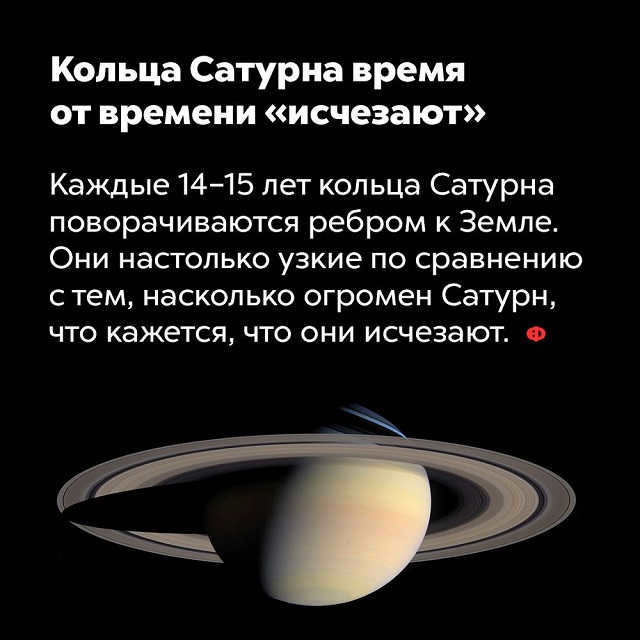
Specifications of the rings
The rings consist of interstellar dust particles, fragments of ice, and small rocks. This unique composition has prevented the rings from disintegrating over time. Rather than being solid objects, each ring is a collection of particles that orbit together. Due to their low density, light is able to pass through the rings.
What are the dimensions of the primary rings? Ring D spans 7,500 kilometers, Ring C measures 17,500 kilometers in width. Ring B is 25.5 thousand kilometers wide, while Ring A has a width of 14.6 thousand kilometers.
The melodies of the rings
The planet’s radio emission gives rise to what is known as the “sounds of the rings,” a celestial symphony. Employing advanced equipment, researchers have managed to capture these harmonies and transform the radio waves into complete audio compositions that can be savored.
The creation of the rings
The rings of Saturn came into existence through a fascinating process. Space debris such as dust, rock fragments, small stones, and ice flakes accumulated around the planet, gradually forming the magnificent rings. These rings are relatively young, with an age of less than 4 billion years, making them younger than the planet itself.
A different theory about the origin of the rings
There exists an alternative explanation for the creation of the rings encircling this celestial body. Several scientists propose that Saturn previously possessed an additional moon. However, as it revolved around Saturn, it approached too near the larger object. As a result of this perilous proximity and the gravitational forces at play, it disintegrated into numerous fragments, which ultimately gave rise to the formation of the rings.
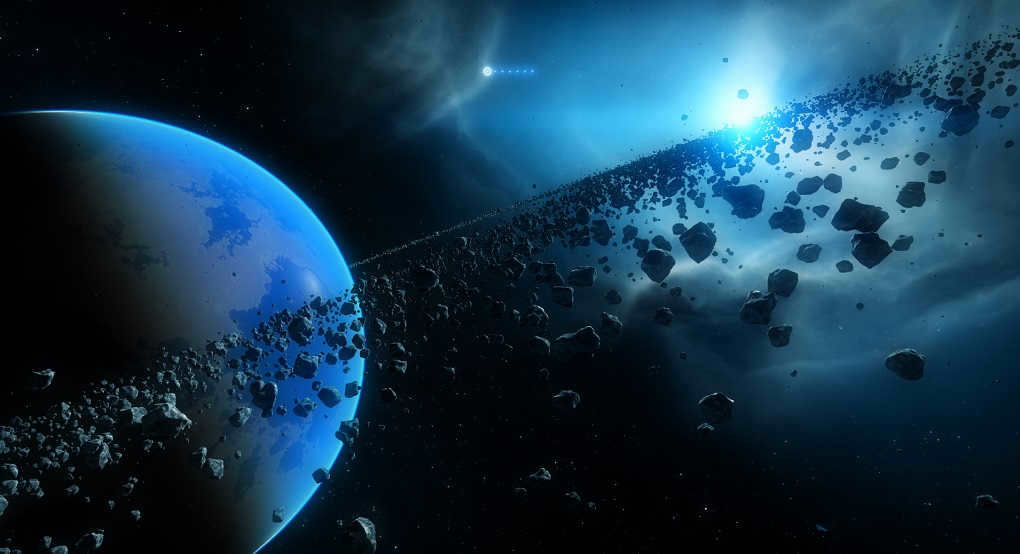
The Satellites of Saturn
Saturn, the beautiful ringed planet, is surrounded by a multitude of fascinating satellites. Here are some of the most well-known among them:
- Titan. This is the largest satellite in Saturn’s orbit, boasting a radius of 2,575 kilometers.
- Rhea. Adorned with numerous craters, Rhea is a captivating sight.
- Hyperion. Close in proximity to the planet, Hyperion is a satellite that captivates astronomers.
- Japetus. With an orbital period of more than 80 days, Japetus takes its time in circling Saturn.
- Mimas. Positioned close to Saturn, Mimas stands out with its distinctive egg-shaped appearance.
- Enceladus. Known for its intriguing geological activity, Enceladus never fails to astound scientists.
- Dione. A sizable and ancient satellite, Dione adds to the allure of Saturn’s celestial entourage.
What is the total number of satellites orbiting Saturn?
The planet Saturn has a total of 62 main satellites, with 9 of them yet to be named.
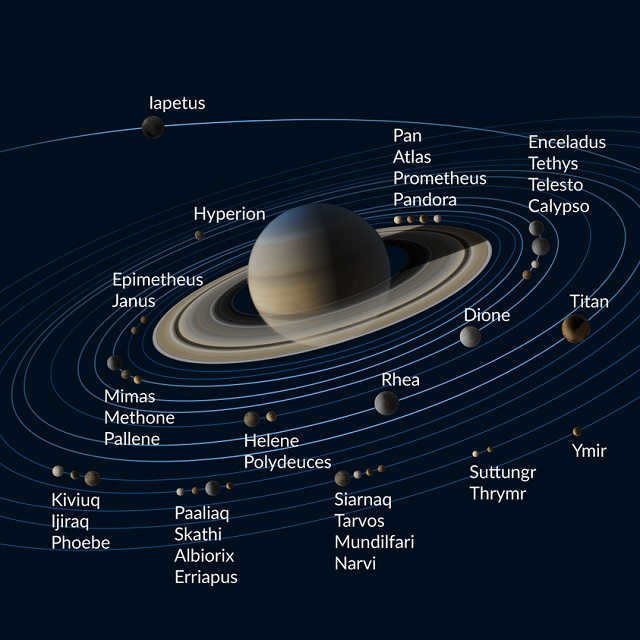
Length of a day
The length of a day on Saturn varies depending on the method of measurement. In the equatorial zone, it takes approximately 10 hours and 14 minutes for the planet to complete one rotation. Measurements in other regions of the planet yield a slightly longer figure of around 10 hours and 39 minutes. However, the most accurate method for determining the length of a day on Saturn is through the calculation of its radio emissions.
Duration of the day based on planet’s radio emission
Scientists have discovered that the duration of the day on this planet is 10 hours, 39 minutes, and 22.4 seconds by analyzing data on its radio emission.
New findings
Recent data, obtained in the 00s, reveal that the duration of the day on this planet is actually 10 hours, 45 minutes, and 45 seconds. It appears that the rotation rate varies due to the influence of the solar wind and changes in the magnetic field’s state.
The gravity on Saturn can only be discussed conditionally, as it does not have a solid surface. However, if we were to imagine a conventional boundary, objects located on it would experience a gravitational force. The gravitational force on Saturn is relatively weak, approximately 91% of that on Earth. For instance, if a person weighs 100 kg on our planet, their weight on Saturn would be around 92 kg. This weak gravity is a result of Saturn’s very low density, as it is primarily composed of gas.
Existence of Life on Saturn
The existence of life on other planets within our solar system has long been a topic of interest for science fiction writers, scientists, and space enthusiasts. However, one celestial body that has not been seriously considered in this regard is Saturn.
This lack of attention is understandable, given the inhospitable nature of Saturn. Composed primarily of gases, the planet experiences extreme temperatures, with surface temperatures reaching as low as -150 degrees. It is difficult to fathom the possibility of any form of life surviving in such harsh conditions.
Life on the moons of the planet
Scientists once believed that certain moons of the planet could potentially support life. This is because these moons are not composed primarily of gas, but rather contain a significant amount of water ice. Additionally, the gravitational forces exerted by the celestial body they orbit could generate enough heat to sustain a habitable environment.
One such moon, Enceladus, is known to have erupting geysers made up of water. The presence of liquid water is considered a key factor in determining the potential for life on a celestial body. It is highly likely that there is a substantial volume of warm liquid water beneath its icy surface.
Titan, another satellite, boasts an entire system of seas and lakes that are filled with liquid hydrocarbons. Scientists hypothesize that it is possible for the origin of life forms based on proteins to have originated there in the distant past. The composition of this moon is believed to be similar to what characterized Earth billions of years ago.
In the future, when the Sun enters a new phase and transforms into a red dwarf, the temperature on Titan may become conducive to the development of life. The seas and lakes may harbor a “primordial broth,” just like they once did on Earth. At that point, Titan could potentially become a habitable world.
The time it takes to fly to Saturn depends on various factors. For instance, Pioneer-11 took approximately 6.5 years to reach the planet, while Voyager One accomplished the journey in a little over 3 years. What are the specific parameters that influence this duration?
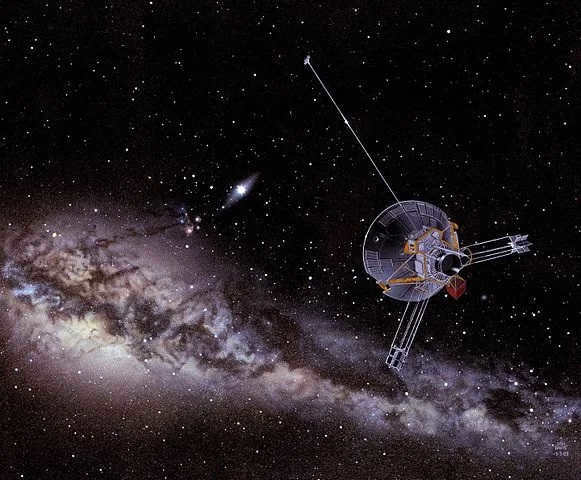
Determining the Duration of the Flight
One of the key factors in determining the duration of a flight is the launch location. The spacecraft can be launched directly from space or utilize another object as a launch pad.
The second factor that determines flight time
The flight time can be influenced by the type and structure of the spacecraft’s engine. Using a faster and more advanced engine can help reduce the time it takes to reach the destination.
Phases of exploration
Scientists conducted the exploration of Saturn in multiple stages.
Pioneer 11, the inaugural probe to successfully reach Saturn, was sent off into space in 1973 and arrived at its destination six years later in 1979. This monumental mission allowed for the unprecedented exploration of the immense “gas giant” from a close proximity and the acquisition of exceptional visual documentation.
Voyager 1
In 1980, Voyager 1, a spacecraft meticulously engineered by scientists, achieved its intended objective. It transmitted an extensive collection of significant photographs back to our planet.
Voyager 2
Voyager 2 successfully arrived at the planet not long after its predecessor in 1981. It not only approached the planet itself, but also came into close proximity with a number of its moons.
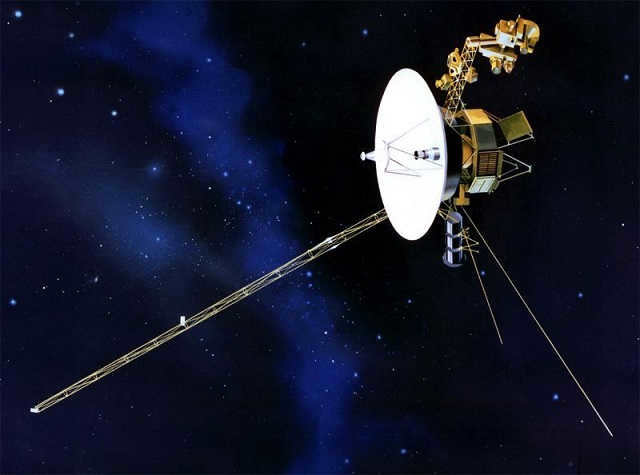
Cassini Huygens Mission
The exploration of Saturn and its largest moon, Titan, was extensively conducted by the Cassini Huygens mission. Launched in 1997, this spacecraft successfully accomplished its mission in 2004, allowing for a comprehensive study of the planet from its orbit. In addition to collecting valuable data, Cassini Huygens also deployed a research probe to the surface of Titan, providing invaluable insights into this enigmatic moon.
There is a forthcoming mission in the 2020s called the Titan Saturn System Mission that will be sent to Saturn. However, we shouldn’t anticipate immediate results from its endeavors: it is projected that the research instruments will reach Saturn’s orbit by 2029, assuming everything goes as planned.
Scientists have a long-term plan for the spacecraft to extensively examine the surfaces of several of the planet’s moons. Enceladus, in particular, is of great interest in this regard, as many believe it could potentially host or originate a protein-based form of life in the future.
Scientists are of the opinion that Enceladus shares striking similarities with the Earth of billions of years ago. During that period, life was in its early stages on our planet, eventually giving rise to the diverse and vast ecosystems we see today. If the parallels are indeed significant, Enceladus emerges as the most promising contender for the birthplace of life.

Interesting trivia
Saturn is an exquisite and captivating planet. It possesses a multitude of educational and astonishing facts about its own existence, as well as its orbiting moons.
More than a hundred moons orbit around Saturn, with 62 of them being considered the primary ones due to their substantial size, and a majority of them even have individual names. This colossal gas giant has attracted approximately 40% of all the moons present in the entire solar system! Additionally, scientists are continuously discovering new, smaller objects that also orbit around this celestial entity.
Life on the surface of this planet has never been seriously considered due to its lack of a solid outer shell and extreme temperatures. It is difficult to envision a protein-based life form that could thrive in -150 degrees Celsius.
However, not all of the planet’s moons share these inhospitable conditions. Enceladus, one of its satellites, is home to geysers. Scientists have long believed that the presence of liquid water is crucial for the potential emergence and sustainability of life.
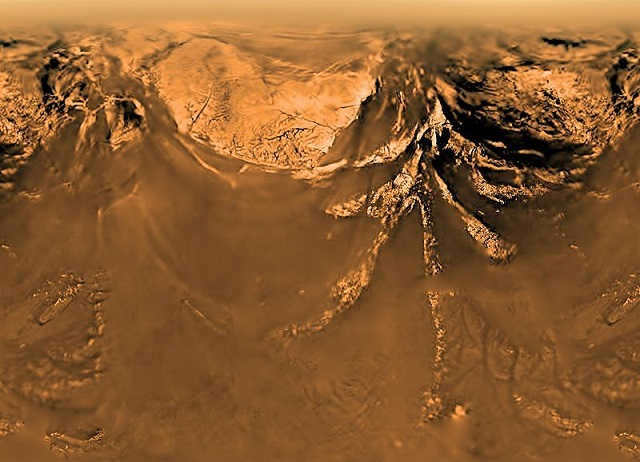
Enceladus and Titan are believed to be the most promising locations for the potential origin of extraterrestrial life forms within our solar system.
The reason why Saturn was named after the god of fertility remains unknown. The ancient Greeks and Romans, who did not have telescopes, were unaware of the existence of the planet’s rings and satellites. However, it is fascinating to consider that Saturn can be associated with fertility in a metaphorical sense, as it is surrounded by numerous orbiting satellites!
The gas giant was formed at the same time as the rest of the planets in our solar system. Approximately 4.6 billion years ago, there was a massive accumulation of gases, dust, and small solid particles in the region where the planet now resides. Through a series of processes, potentially including a collision with another celestial object, this accumulation began to contract and assume a spherical shape, eventually becoming the planet we recognize today.
The planet’s atmosphere has a lower density compared to the water we are familiar with. In fact, it has the lowest density of any planet in our solar system. This low density also contributes to Saturn’s relatively weak gravitational pull.
The planet has a unique shape, being slightly flattened at the poles instead of perfectly spherical as often depicted in images, illustrations, and three-dimensional models.
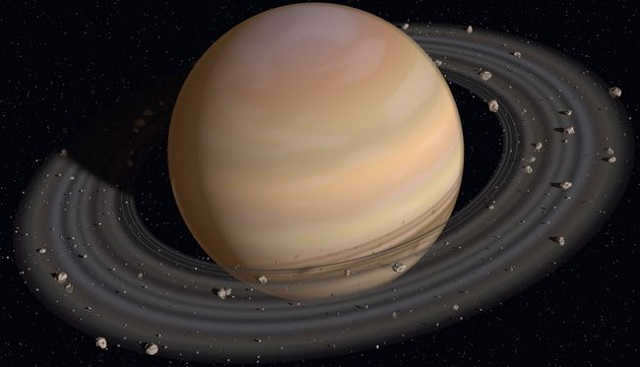
When the first explorers observed Saturn through a telescope, they initially believed that it lacked rings and instead had numerous moons. This was the belief held by Galileo Galilei in the early 17th century. However, as telescopes improved over time, scientists were astounded by what they discovered. The first satellite to be identified was Titan, but researchers continue to uncover new, smaller satellites even today. It is widely believed that there are still more satellites of Saturn that have yet to be found and fully described.
There have been only 4 spacecraft that have successfully entered into the orbit of Saturn. Due to its distance from Earth, Saturn has received less scientific attention compared to closer celestial bodies like the Moon or Mars. However, scientists have exciting plans for new missions to gather more knowledge about Saturn and its moons. Of particular interest are the moons that might have the potential to support life forms based on proteins.
There is still ongoing debate among scientists regarding the origins of Saturn’s rings. Two main hypotheses are currently competing with each other. Some researchers propose that the rings formed from a collection of small ice particles, dust, and other space debris. On the other hand, there is a belief that the rings are remnants of a former large satellite of the planet. This satellite once orbited Saturn but eventually approached the planet too closely, resulting in its gravitational force tearing it apart into smaller particles that eventually formed the rings.
Records from ancient Babylon provide the earliest evidence of human knowledge about the existence of Saturn. Even in those ancient times, priests would calculate horoscopes for individuals based on the position of this celestial object in the sky on the day of their birth as well as its current location.
The advancements in telescope technology have greatly contributed to our understanding of this planet. As telescopes became more powerful, we were able to discover new things about Saturn. In the 1970s, we achieved a major milestone by successfully launching a research vehicle into Saturn’s orbit, allowing us to capture unique and high-quality photographs.
The satellites of Saturn can be categorized into different groups based on their location and distance from the planet. There are regular and irregular satellites, each belonging to larger divisions. These divisions further consist of smaller groups, which contain multiple space objects.
How to spot in the sky
Spotting this celestial body in the sky can be accomplished without the need for any specialized technological equipment. But how can one go about doing so?
The ideal moment to catch a glimpse of Saturn is during its opposition to Earth, when it comes closest to our planet. To determine the exact dates of these occurrences in the near future, one can consult specialized websites. Once the appropriate time has been calculated, the planet should be observed in the southwestern region of the visible horizon. The further north an observer resides, the slimmer their chances are of spotting this planet.
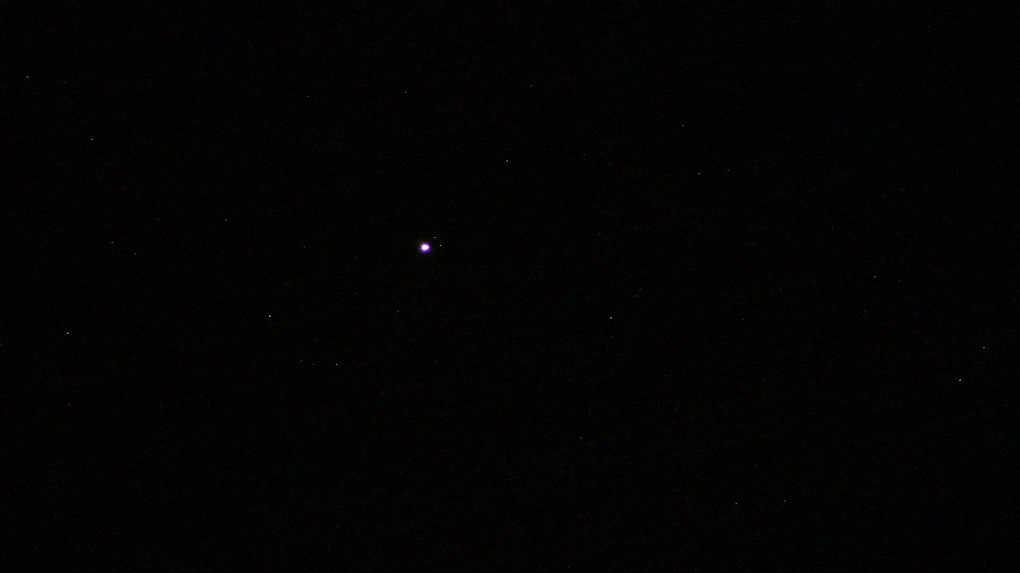
On the clearest night, only Saturn itself is visible. The rings of Saturn can only be observed through a telescope.
Frequently Asked Questions
- Who is this celestial object named after? It is named after a deity from the ancient Roman pantheon. This deity was associated with fertility.
- When was this planet discovered? Giving a precise and definitive answer to this question is impossible. Humans have been aware of its existence since ancient times.
- What is the distance between Saturn and the Sun in space? The distance between Saturn and the Sun is 1.43 billion kilometers, which is equivalent to 9.58 astronomical units.
- To identify this object in the sky by yourself, it is recommended to utilize specialized astronomical search maps or dedicated programs designed for this purpose.
- What are the exact coordinates of this celestial object? It’s difficult to determine as they are constantly in flux. The most reliable approach is to consult specialized astronomical websites and programs to obtain its ephemerides.
- In 2022, researchers proposed the possibility of life originating on Enceladus, one of the planet’s moons, due to the presence of warm and salty water. Similar conditions existed in the oceans of our planet billions of years ago when life first emerged;
- In 2021, the discovery of methane on the same moon has led some scientists to believe that it could be a sign of life, as certain organisms produce this gas as a byproduct of their metabolic processes;
- In 2021, the development of a state-of-the-art spacecraft to investigate the planet’s moons was announced. However, it is scheduled to be launched in the mid-2020s and will reach its destination around 2030;
- The total number of known moons has increased to 145, although only approximately 50 of them have been officially named.
- Scientists have made an intriguing finding – true precipitation can occur beneath the outermost layers of a planet’s atmosphere. However, these rains primarily consist of liquid helium.
- A fascinating theory posits that Saturn’s iconic rings may eventually vanish. This is due to their gravitational attraction to the massive planet, but this process is expected to take at least 100 million years.
Watch authentic footage of Saturn
Saturn is classified as a gas giant, signifying its immense size compared to Earth and its composition primarily consisting of gas. Consequently, Saturn lacks a solid surface in the conventional sense. However, at its core lies a solid silicate core, encompassed by layers of ice and metallic hydrogen. This amalgamation is incredibly compressed due to the pressure exerted by the surrounding matter. As we ascend further, the compressed matter transitions into a semi-liquid state and eventually into gas. Saturn’s atmosphere is undeniably robust and exhibits a complex structure. (For detailed information on the chemical composition of Saturn’s atmosphere, refer to the end of this article.)
The atmosphere of Saturn differs from that of Earth. It is composed of 94% hydrogen, the lightest gas, and nearly 6% helium (which is also a lightweight gas commonly used to fill balloons). Saturn’s atmosphere is most comparable to Jupiter’s atmosphere and even to the Sun’s composition! This is not surprising, as hydrogen and helium are the most abundant elements in the entire universe..
In addition to hydrogen and helium, trace amounts of other gases have been detected on this ringed planet. However, these compounds make up less than 1 percent of the atmosphere’s overall volume.
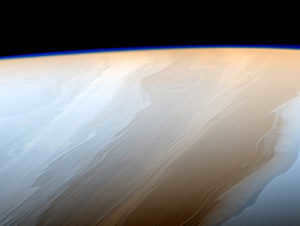
Atmospheric Composition
The outer layers of Saturn’s atmosphere are all that we are able to observe. These layers have a similar complex structure as those on Jupiter, but with less visible detail. Furthermore, the observed details often appear low-contrast and blurry.
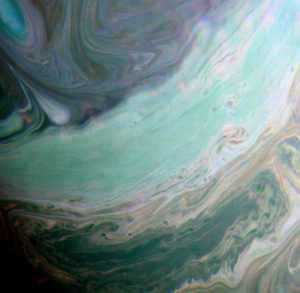
The main reason for this is that Saturn is located farther from the Sun compared to Jupiter. Hence, the upper atmosphere of Saturn is significantly colder in comparison to Jupiter’s. Consequently, a dense layer of mist forms in this region, which obscures the arrangement of the clouds and belts beneath.
However, there is another factor: the winds on Saturn blow with greater intensity than those on Jupiter. They have the ability to swiftly dismantle any hurricanes and cyclones, consistently flattening the atmosphere.
The haze in Saturn’s atmosphere is not entirely opaque. It allows for visibility of the clouds beneath it. The clouds exhibit a fusion of yellow, gray, and brown hues. The configuration of the clouds is distinctly apparent in imagery captured by the Cassini spacecraft, which encircled Saturn between 2004 and 2017.
The motion of the atmosphere on Saturn is constant, which can be observed even with amateur telescopes. When using a 90 to 100 mm lens, one can see that Saturn’s disk is segmented into belts or zones. The clouds within these belts move at varying speeds. In the equatorial regions, wind speeds can reach up to 500 meters per second! However, in the temperate latitudes, the wind speed decreases to nearly zero.
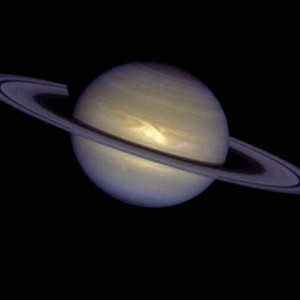
Saturn, the sixth planet in our Solar System, is one of the notable giant planets. An intriguing aspect of Saturn is its stunning ring system, composed primarily of ice and dust particles. Additionally, Saturn boasts numerous satellites orbiting around it. The ancient Romans named this planet after their revered god of agriculture, emphasizing its significance in their culture.
A Short Summary
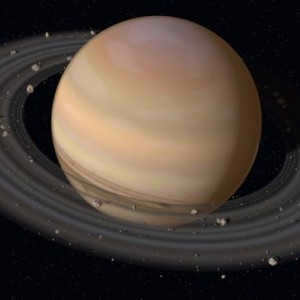
Saturn’s ring system is a breathtaking spectacle. Composed of ice, rock, dust, and the remnants of former satellites destroyed by its immense gravitational force, they are positioned high above the planet’s equator, spanning a distance of approximately 6 to 120 thousand kilometers. Despite their vast expanse, the rings themselves are remarkably thin, with each measuring only about a kilometer in thickness. The entire system is comprised of four distinct rings, three of which are considered the primary rings, while the fourth is comparatively thinner. The first three rings are traditionally designated by Latin letters, with the middle ring, known as Ring B, being the brightest and widest. This ring is separated from Ring A by a space known as the Cassini gap, which contains the thinnest and nearly transparent rings. Interestingly, it is not widely known that all four of the gas giant planets possess rings, although Saturn’s rings are by far the most prominent and observable.
There are currently 62 confirmed satellites orbiting Saturn. Among them, the most notable ones include Titan, Enceladus, Mimas, Tefia, Dione, Japetus, and Rhea. Titan, being the largest of Saturn’s satellites, shares many similarities with our own planet Earth. It boasts a layered atmosphere and even has liquid on its surface, a fact that has been scientifically established. Additionally, there are smaller celestial bodies that are believed to be remnants of asteroids, with some measuring less than a kilometer in diameter.
Formation of planets
There are two theories regarding the origin of Saturn:
The first theory, known as the “contraction” hypothesis, suggests that the Sun and the planets formed in a similar manner. During the early stages of the solar system’s formation, there was a disk composed of gas and dust. Within this disk, certain regions gradually became denser and more massive than the surrounding matter. These condensed regions eventually gave rise to the Sun and the planets as we know them today. This theory also explains why Saturn shares a similar composition with the Sun and has a relatively low density.
Based on the second “accretion” theory, Saturn’s formation occurred in a dual process. Initially, dense objects similar to the rocky planets in the Earth’s group were created within the gas and dust disk. During this phase, a portion of the gases near Jupiter and Saturn dissipated into the vacuum of space, accounting for the slight disparity in composition between these planets and the Sun. In the subsequent stage, larger objects drew in gas from the encompassing cloud.
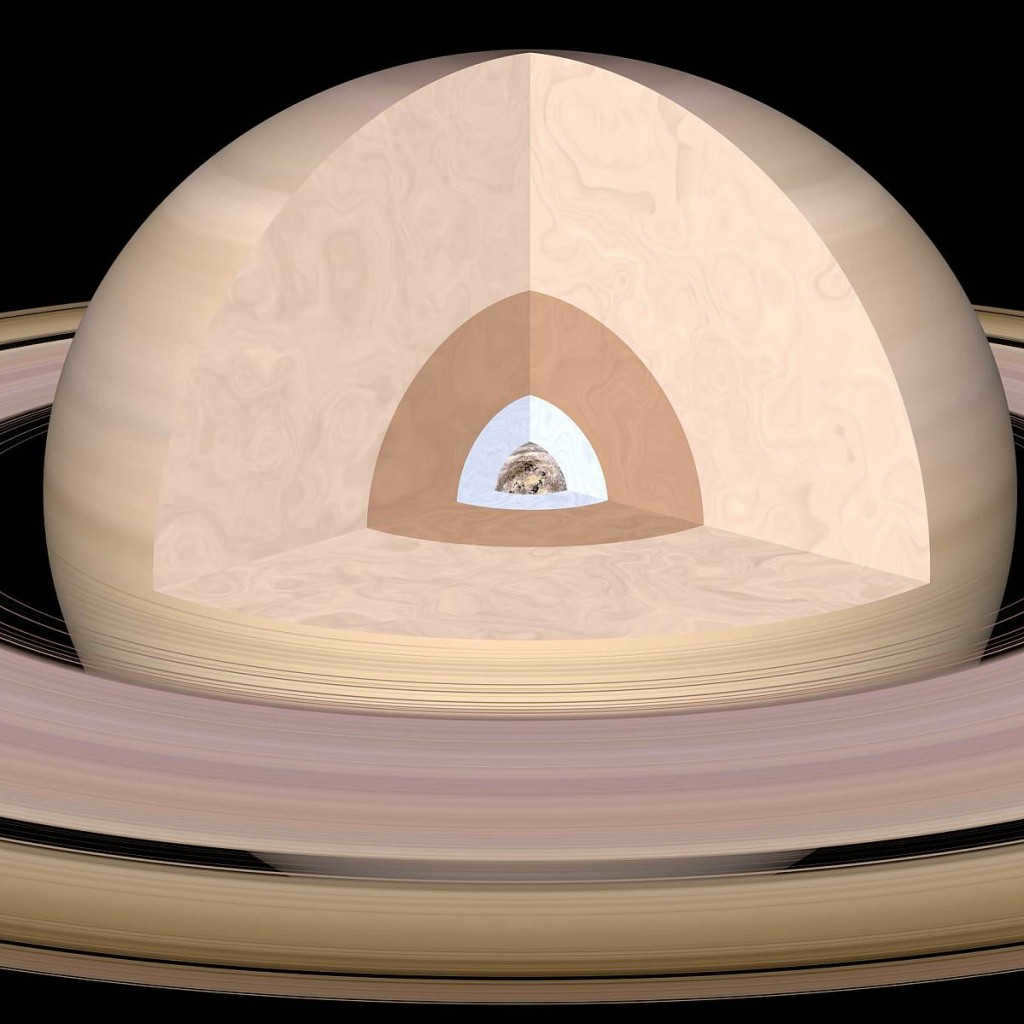
The core of Saturn is enveloped by a layer of metallic hydrogen, which is in a liquid state but possesses metallic properties. This metallic hydrogen exhibits remarkably high electrical conductivity, resulting in the generation of a robust magnetic field due to the circulation of currents within it. This layer is located approximately 30,000 kilometers below the planet’s surface and experiences pressures of up to 3 million atmospheres. Above this layer, there exists a region of liquid molecular hydrogen that transitions into a gaseous state as altitude increases, eventually coming into contact with the planet’s atmosphere.
Atmosphere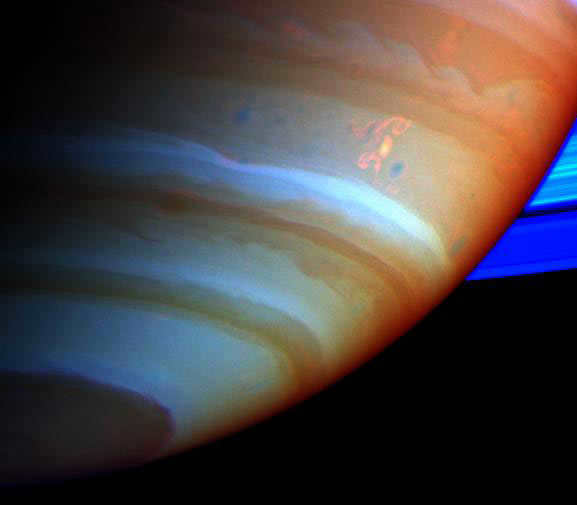
In the case of gas giants like Saturn, it is challenging to pinpoint the exact starting point of the atmosphere due to the absence of a solid surface. However, scientists consider the altitude at which methane boiling occurs as a reference point. Saturn’s atmosphere is primarily composed of hydrogen (96.3%) and helium (3.25%). Extensive spectroscopic studies have also revealed the presence of water, methane, acetylene, ethane, phosphine, and ammonia in its composition. The pressure at the upper boundary of the atmosphere is approximately 0.5 atm, where ammonia condenses and forms white-colored clouds. Closer to the surface, the clouds consist of ice crystals and water droplets.
The gases within the atmosphere are in constant motion, resulting in the formation of parallel stripes along the planet’s diameter. Similar streaks are observed on Jupiter, although they appear less pronounced on Saturn. Convection and the planet’s rapid rotation generate incredibly strong winds, making them the most powerful in the entire solar system. These winds primarily blow in an eastward direction, following the planet’s rotation. Near the equator, the air currents are particularly vigorous, with speeds reaching up to 1800 km/h. As one moves away from the equator, the winds gradually weaken, giving rise to westward currents. The movement of gases occurs across all layers of the atmosphere.
Large cyclones can have a long duration, lasting for many years. Approximately every 30 years, Saturn experiences the phenomenon known as the “Great White Oval”, a highly powerful hurricane that increases in size with each occurrence. During the most recent observation in 2010, this hurricane covered a quarter of the planet’s surface. Additionally, interplanetary stations have detected a peculiar formation in the shape of a regular hexagon at Saturn’s north pole. This hexagon has maintained its shape for a period of 20 years since its initial discovery. Each side of the hexagon measures 13,800 kilometers, which is larger than the Earth’s diameter. Astronomers are still puzzled by the cause of this unique cloud formation.
Rings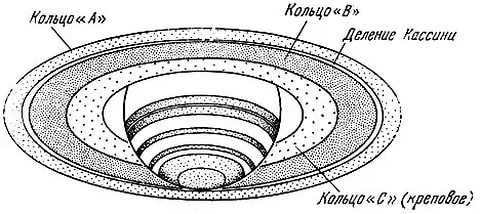
Saturn is known for its magnificent rings. The planet is surrounded by a system of rings made up of countless small particles of ice and rock. These rings create a breathtaking spectacle and add to the unique atmosphere of Saturn. The rings, which are believed to be billions of years old, are constantly changing and evolving due to the gravitational forces exerted by Saturn and its moons. Scientists are still studying the formation and composition of these rings to better understand the dynamics of the Saturnian system.
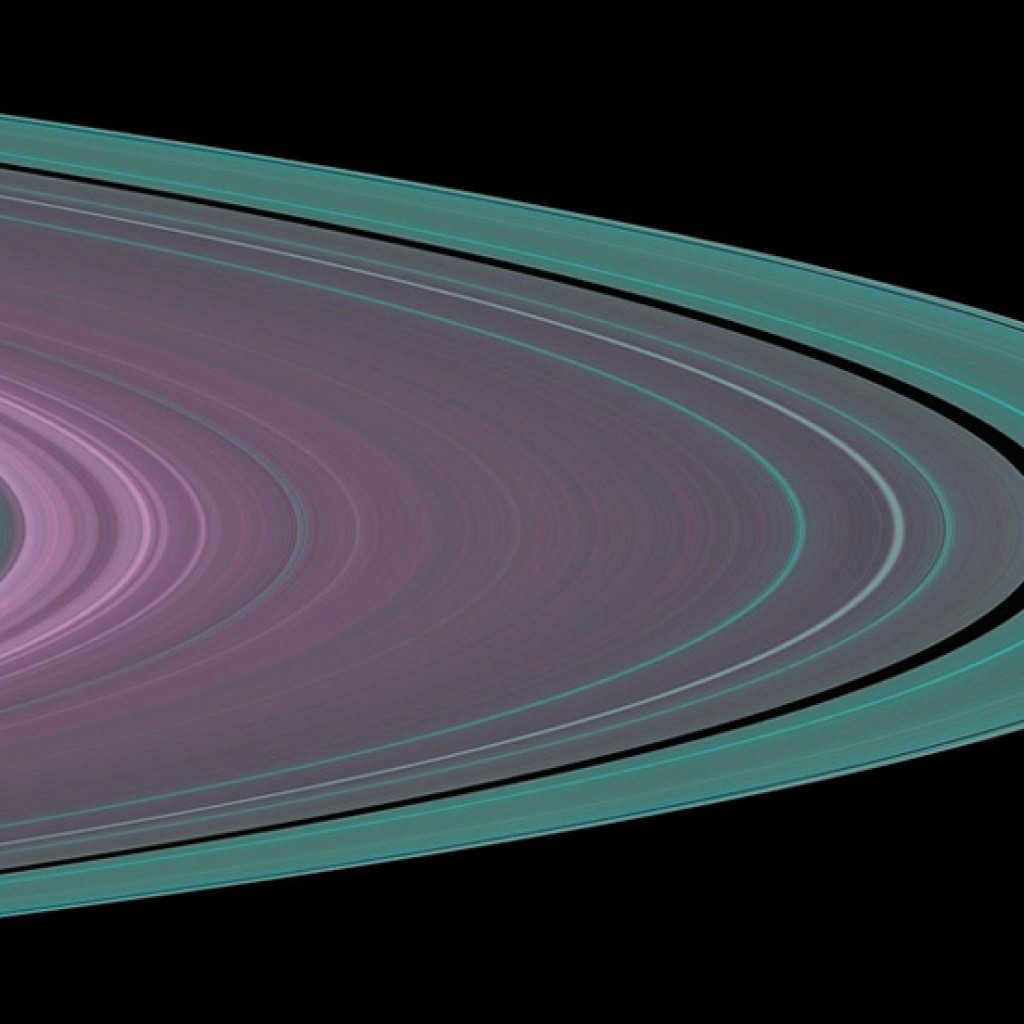
There are multiple hypotheses regarding the origin and creation of Saturn’s rings. One theory proposes that the rings were formed when the planet captured some of its moons, which then disintegrated and scattered their fragments into orbit. Another theory suggests that the rings were formed simultaneously with the planet itself, emerging from a primordial cloud of gas and dust. The particles that compose the rings are too small, chaotic, and prone to collisions, preventing them from coalescing into larger objects like moons. It is important to note that Saturn’s ring system is not entirely stable: some of the material is lost, either absorbed by the planet or dispersed into the surrounding space, while other material is replenished through interactions with comets and asteroids influenced by the planet’s gravitational field.

